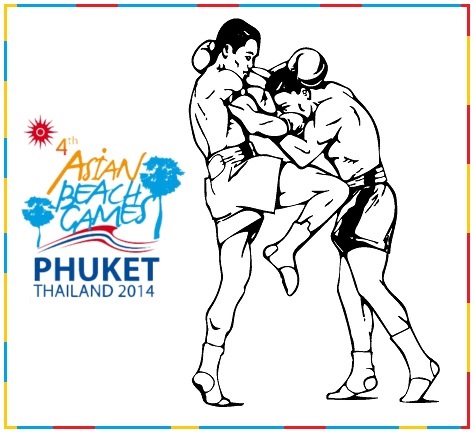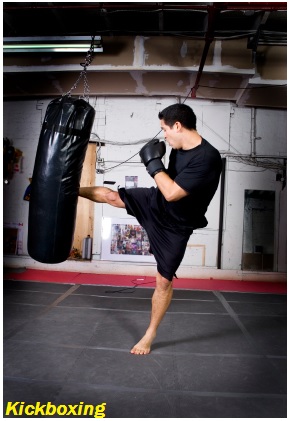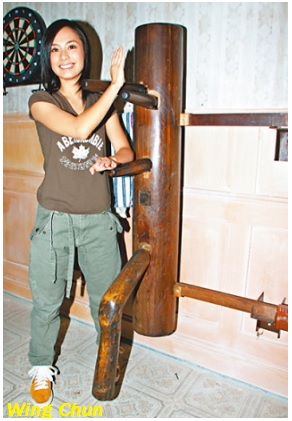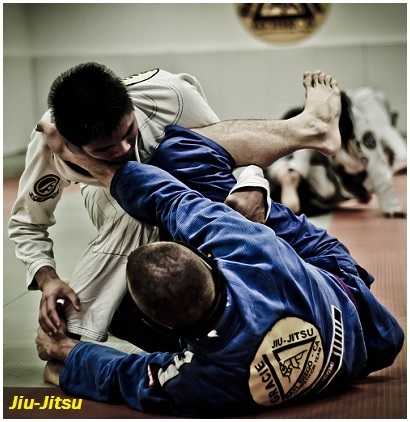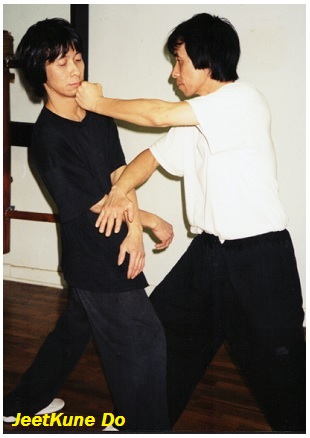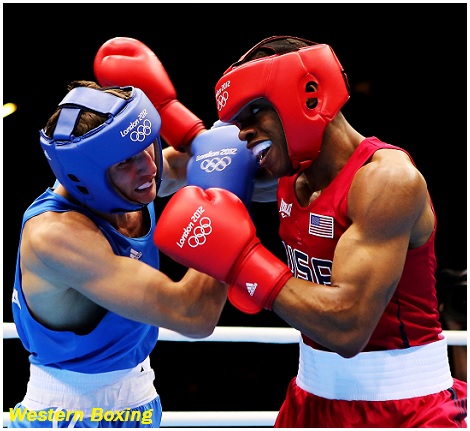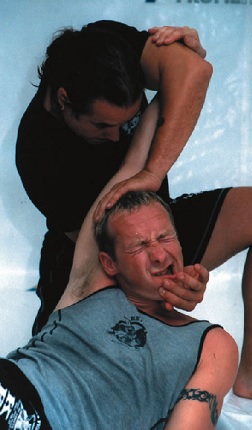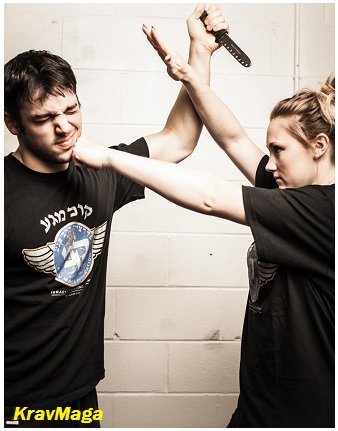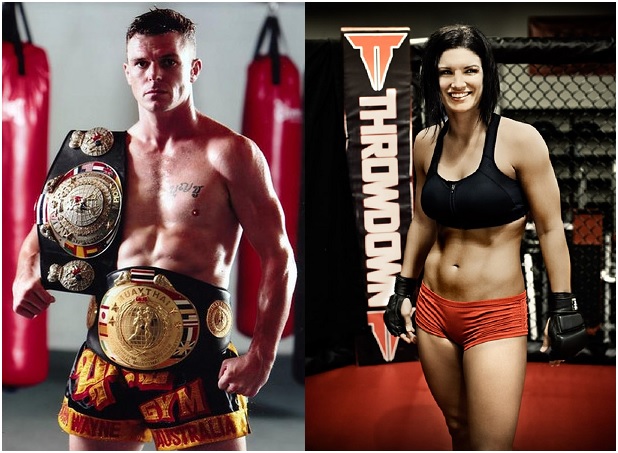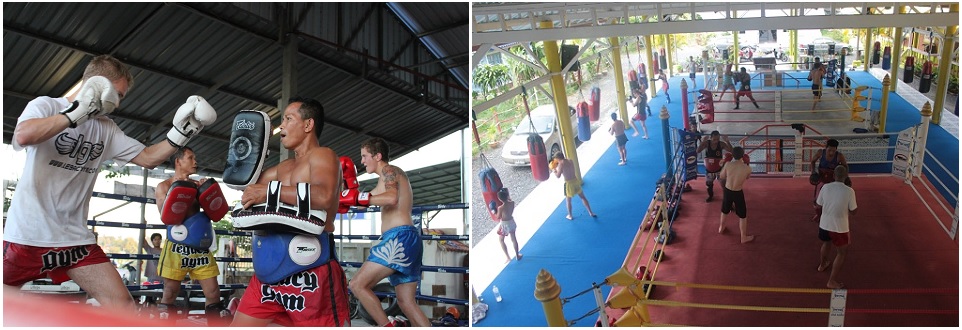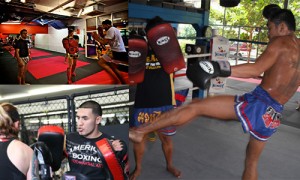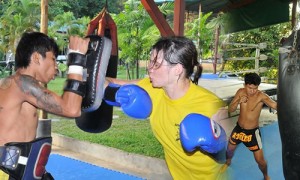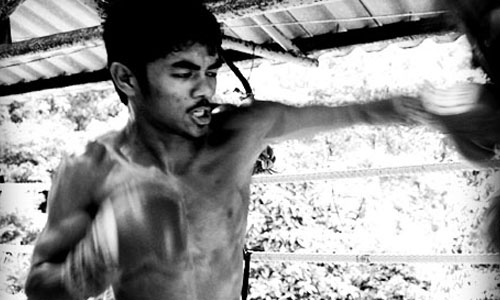Tag Archives: Muay Thai
Mixed Martial Arts or Muay Thai
Mixed Martial Arts
A popular form of self defense and combat sport has caught the interest of a lot of fitness conscious and martial arts enthusiasts in various parts of the world – Mixed Martial Arts or MMA. This is a full contact combat sport that makes use of striking and grappling techniques from a variety of other combat sports. Such techniques may be done while standing or on the ground. While the roots of modern mixed martial arts can be traced back to the ancient Olympics where a full range unarmed combat was evident in the sport known as ‘pankration’, the same MMA has a short history as the first Ultimate Fighting Championship or UFC event that took place on November 12, 1993, brought to the United States from Brazil by the Gracie family. Martial arts of various styles and different background have since evolved from the dangerous vale-tudo-style bouts of the early UFCs to the regulated form of MMA seen and used today.
MMA in the early days was all about which martial arts style was the best, thus the MMA fighters cross-train in all of the styles that have proven effective in the sport including, Brazilian Jiu Jitsu, Jeet Kune Do, Karate, Judo, Kung Fu, Kickboxing, Muay Thai, Kyokushin, shootfighting, Shotokan, Russian Sambo, Tae Kwon Do, Wrestling, and Tang Soo Do.
Muay Thai
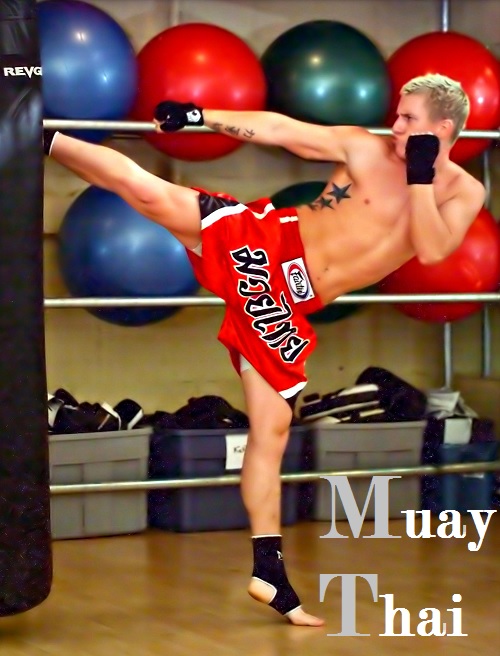 Muay Thai, on the other hand is an ancient art of self defense that originated from Thailand which has grown in recent years into a popular and sought after combat sport within the boundaries of Thailand and in other parts of the world. This form of self defense uses all eight body weapons, hence, it was known as the “art of eight limbs”. Muay Thai uses the hands, knees, elbows, and feet and is considered to be the most effective stand up art of fighting on earth. In the past, or in Muay Boran (old style Muay Thai) the head is used as the 9th weapon. Modern day Muay Thai has eliminated the head as a weapon.
Muay Thai, on the other hand is an ancient art of self defense that originated from Thailand which has grown in recent years into a popular and sought after combat sport within the boundaries of Thailand and in other parts of the world. This form of self defense uses all eight body weapons, hence, it was known as the “art of eight limbs”. Muay Thai uses the hands, knees, elbows, and feet and is considered to be the most effective stand up art of fighting on earth. In the past, or in Muay Boran (old style Muay Thai) the head is used as the 9th weapon. Modern day Muay Thai has eliminated the head as a weapon.
Muay Thai techniques are divided into two groups – mae mai or major techniques, and luk mai or minor techniques. Almost all Muay Thai techniques use the entire body movement – rotating the hip with each kick, punch, elbow and block. Muay Thai is often used as a fighting art of attrition, where opponents exchange blows with one another.
Comparison between MMA and Muay Thai Fighting
MMA
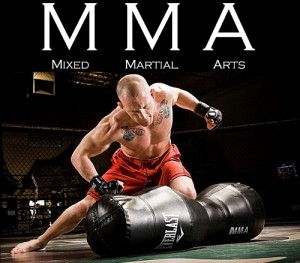 MMA matches are characterized by the various martial arts styles integrated into the fighting techniques of mixed martial arts. This includes stand up fighting such as punches, clinch work, knees, kick, and elbows; throwing or takedowns, and ground fighting such as submissions, submission defense and ground control.
MMA matches are characterized by the various martial arts styles integrated into the fighting techniques of mixed martial arts. This includes stand up fighting such as punches, clinch work, knees, kick, and elbows; throwing or takedowns, and ground fighting such as submissions, submission defense and ground control.
Muay Thai
Muay Thai is a hard striking form of martial art where all eight limbs are used to fight and throw strikes are opponents. However, one of the many things that set Muay Thai apart from other striking styles is the use of clinching. Muay Thai, unlike other martial arts styles such as Japanese kickboxing and western boxing separate fighters when they begin to grab one another inside, welcomes this kind of fighting. Practitioners will oftentimes grab the back of their opponents’ neck in such situations and utilize knee strikes to the midsection. The use of elbow strikes is another feature that sets Muay Thai from other martial arts styles.
Basic Goals of MMA and Muay Thai
The rules of MMA combat may vary depending on the MMA organization holding the event. But regardless of the rules, MMA is a sport where combatants attempt to either defeat their opponent via stoppage or by decision which is rendered by judges and are based on the fighting criteria.
In Muay Thai competition, the basic goal is to win the fight by either knockout or by way of decision. Outside the competition, Muay Thai’s goal is to defend against an opponent as quickly and effectively as possible.
There are camps who offer training for these combat sports. Here is an example of a Muay Thai training camp in Phuket. These training camps do hone their fighters to be the best on their divisions.
Muay Thai included in the Fourth Asian Beach Games
The entire country is ecstatic about the fantastic news that the Olympic Council of Asia (OCA) has included Muay Thai in the Asian Beach Games which Phuket, Thailand is set to host in 2014. This news came after Thailand officials inked a deal with the Olympic Council of Asia on November 13, 2012. Phuket Governor Tri Augkaradecha, Olympic Committee of Thailand President Yuthasak Sasiprapha, and Tourism and Sports Minister Chumpol Silpa-archa were all present in the signing ceremonies with OCA President Sheikh Ahmed Al-Fahad Al-Sabah. Thailand is good to go for the 4th Asian Beach Games in 2014.
This will mark the second games event under the OCA that Muay Thai has been included. The first was during the Asian Indoor and Martial Arts Games. The Asian Beach Games happen every two years. The first event was hosted by Bali, Indonesia in 2008, where Thailand came in second behind Indonesia in terms of gold medals won.
Phuket Governor Tri said that the prestigious sports event is expected to generate as much as one billion Baht in income for the province as it gives the country the opportunity to show off to the world its ability to host world-class international sporting events such as the Asian Beach Games. Thailand has allocated a provisional budget for the games at 500 million Baht which will be reviewed by a supervisory committee, if there is a need for the figure to be reduced or increased.
Along with tourism, Muay Thai will receive an unprecedented promotional mileage with its inclusion in the events. Thailand could build on a successful hosting of the Asian Beach Games in 2014 to attract even bigger and more prestigious sports events to the country in the future. Thailand would readily step in, if any country in the region is not ready to host similar events.
Phuket is already one of Thailand’s most popular tourist destinations. With the coming Asian Beach Games 2014 where most of the events will take place in Patong and Karon, the country can expect an even higher tourist arrival as the event date draws near.
For Muay Thai pioneers, this could be a big opportunity to promote the national sports even as it already enjoys significant popularity in foreign soils. The inclusion of Muay Thai, not as a demonstration game but as one of the events in the games is indeed a great feat for the country.
The Asian Beach Games 2014 will feature 15 to 20 events including some or all of the following:
- handball
- kabaddi
- takraw
- volleyball
- sailing
- paragliding
- football
- water skiing
- bodybuilding
- windsurfing
- jet-skiing
- triathlon
- woodball
- swim marathon
- boat racing
- pencak silat
- muay thai
- extreme sports
- climbing
- wakeboarding.
The watchwords of the 2014 Asian Beach Games will be warmth, happiness, friendship and mutual respect, according to OCT President Gen. Yuthasak.
Martial Arts for Self Defense
A lot of people take special interest in Martial Arts. It’s probably because the world is getting dangerous every day. And the idea that your learned skill will give you some kind of protection from any adversary is enough motivation to pursue Martial Arts lessons. The following lists down the famous Martial Arts for self- defense.
Kickboxing. For self-defense, kickboxing focuses on fast-paced, distracting and accurately aimed at all open opportunities with the punches, kicks and knees. The most famous offshoot of kickboxing is Muay Thai which makes use of the hands, feet, knees, and elbows as the weapon to ward off an attacker. The assailant may have a knife or a gun and may use it, but a kickboxer can distract an opponent with his strikes as he uses all his 8 body weapons to disarm or rid the enemy with any harmful weapon.
Karate. It is primarily a striking art with emphasis on attack deflection, using kicking, punching, knee, elbow strikes and open-handed techniques such as knife-hands and ridge-hands. Grappling, restraints, locks, throws and vital point strikes are learned.
Aikido. This interesting martial art is performed by blending with the motion of the attacker and redirecting the force of the attack instead of opposing it head-on. With few striking moves, Aikido is based on the principle that an attack from an opponent will allow you to strike back at his vulnerable points.
Wing Chun. Bruce Lee learned this Kung Fu art from Yip Man, which Lee found too slow and formal for self-defense. He developed his own version of Wing Chun where he addressed the inadequacies he found in Wing Chun. Lee still used Wing Chun’s signature punches – fast, rapid-fire left, right punches to the attacker’s chest instead of the belly or the throat. The target is the sternum or solar plexus.
Jiu-Jitsu. This is the most universal style of martial art. It incorporates elements of hard striking, grappling, eye gouging, choke holds, joint locks, biting and the awareness of the defender’s center of gravity against the attacker’s center of gravity. By lowering your center of gravity under his, jerking him over or around you, you will be able to throw your attacker.
Jeet Kune Do. This is Bruce Lee’s enhanced version of Wing Chun. Bruce Lee worked on the principle of a “style without a style” where you ought not to be thinking anything but the attack of the opponent and your response to such attack. If thoughts are not cleared from the head, they will slow you down. Only one stance is used – the western fencing “en garde” stance.
Western Boxing. All a boxer needs is one swing. Boxers throw punches harder, faster and more accurately than any other trained fighter on earth. To punch properly, boxers spend 4 years of training. And because boxing does not allow kicking, boxers put all their strength in their hands.
Brazilian Jiu-Jitsu. This is an offshoot of Japan’s jiu-jitsu which mixes the original jiu-jitsu’s standing throws and strikes with ground fighting, emphasizing on manipulating joints and overall control of the attacker or opponent.
Keysi Fighting Method. This has almost no kicks. It makes use of every weapon the body can quickly wield – fist, head, knees and elbow. This art is designed to strike with the sharp elbows which are more powerful than straight punches because they employ the entire upper body in bringing the firm muscle, from the root of the little finger to the wrist, down like a hammer against the target.
Krav Maga. This is Israel’s national martial art that follows a no-holds-barred incapacitation for the purpose of street survival. It incorporates many martial art elements such as western boxing punches, Greco-Roman wrestling, Brazilian Jiu-Jitsu ground fighting, Karate kicks and knees, Jiu-jitsu’s throws and grappling.
Learning self defense could be your saving grace in times of trouble. It is somehow important to at least learn the basics of any of these martial arts for self defense. If you want to learn Muay Thai, there are great Muay Thai training camp in Phuket that have been so popular to both locals and foreign nationals who want to learn the sport. By enrolling in these Muay Thai training camps, you’ll be taught not only the sport but great discipline, focus and total balance. Learn the other benefits of Muay Thai by clicking this.
List of Lethal Martial Arts ever Created
People have perpetually strived to find, develop and use the most effective ways of defending one’s self and inflicting pain to the opponent. In ancient times they used stones and sticks. This has developed into sometimes artful but seriously lethal martial arts. The following are 10 most lethal arts ever developed and currently in use.
- Rough and Tumble. This is one of the few fighting styles indigenous to the United States, which grew popular during the American Revolution or thereabout. It’s laden with violence and places emphasis on maximum disfigurement of the opponent. Often, it involves gauging out each other’s eyes or biting the opponent’s tongues. This is one bloody and violent form of fighting between opponents.
- Muay Thai. Known as the “Art of Eight Limbs”, this combat sport makes heavy use of elbow and knee strikes. This deadly form of self defense emerged from Thailand. The birth of Muay Thai was known to be used as defense against an early colonization.
- Krav Maga. This is the world’s most dangerous martial arts and it came from one of the most beleaguered regions of the world – Israel. This non-sport martial arts was developed for use by the Israeli Defense Force or IDF, completely without regard for the opponent’s well-being. The entire self-defense concept is based on the assumption that the opponents are out to kill you. And therefore, it is fitting to fight off with brutal techniques that will inflict serious pain to the opponent and in most cases often end up in the death of the adversary.
- Bacom. This is also called Vacon, a Peruvian martial art developed in the streets of Lima, combining several martial arts that will quickly inflict maximum injury and harm to the opponent. This also involved use of hidden weapons and deceiving tactics which almost always result in the opponent’s death.
- Pugilism. This combat sport is also known as boxing but has developed many variations across the globe. Those using this martial art targets the head for serious harm and because of this was outlawed in several countries in the 19th century.
- LINE. Linear Infighting Neural override Engagement is a combat technique used by the US Marine Corps in the 1990s which almost always involved killing the opponent. It is still used by some of the special forces. Due to its lack of flexibility, LINE was succeeded by the Marine Corps Martial Arts Program or MCMAP in recent years. LINE’s dangerous and lethal techniques are not applicable in peacekeeping operations or other non-emergency situations.
- Vale Tudo. This is a Portuguese word that means “anything goes”. This full contact combat sport, famous in Brazil has no many rules and adopts techniques from a variety of martial arts. This has grown to be an extremely bloody and harmful combat sport that it had to go underground.
- Ninjutsu. This originated from feudal Japan where shinobi or ninja practiced this martial art which focused on non-traditional fighting techniques, surveillance and assassination. The practitioners were sometimes referred to as non-humans or “hinin”.
- Jailhouse Rock. This involved numerous improvisational fighting techniques developed within the US jail system and some of the most common types are Brick City Rock, 52 Handblocks and Stato. This is practically a non-existent martial art because not much is known about them.
- Kapu Ku’ialua. Some call it Lua, a non-traditional martial art from Hawaii that is focused on breaking bones, twisting joints and even open ocean warfare. The name means “two hits”. Practitioners elect to use odd means to secure a win such as coating their bodies with coconut oil so opponents cannot get a grip on them during a fight.
Practicing any kind of lethal martial arts above could be synonymous to fatal injury. Since most martial arts presented above are considered lethal, having strict provisions and formulating rules that would not compromise the fighter’s life in continuously practicing the sport is present.
Benefits of Muay Thai Training
Muay Thai, a martial art form that originated from Thailand, also known as the “Art of Eight Limbs,” which is focused on strikes using the eight points of contact: feet, knees, elbows and fists. It uses the power of rotation in the hips to deliver dynamic and strong punches, elbows, blocks, and kicks.
Muay Thai is also an effective health and fitness training. It can improve one’s health and give a physically fit and strong body. Muay Thai workouts and training not only get a trainee in the best fighting form, he can also benefit from them health-wise. This may be the reason why a lot of people are interested and attracted in Muay Thai. Even if they are not training for a Muay Thai fight, they are after the health benefits the training will give them. People who go into Muay Thai training can build stronger and more defined arms, legs and stomach. In many ways, the training also helps to gain a sense of inner strength and emotional balance.
Muay Thai training is known for its rigid training program which includes an innovative variation of sparring, jabs, power punches, and defense techniques and all blends of aerobics exercises. Muay Thai training camps in Phuket, Bangkok and other places in Thailand come up with best training package that would not only entice Muay Thai enthusiasts to enroll but would encourage fighters to better their craft in the sport. These intensive workouts will help the Muay Thai trainee learn the proper execution of the different Muay Thai fighting techniques and help keep them physically fit and stronger.
Other than preparing the body for the physical stress and stand the impact of the opponent’s strikes, there are fitness, social and defense benefits that Muay Thai provides.
Fitness Benefits of Muay Thai
- Well-proportioned body. People who are into Muay Thai training are taught to perform warm-up exercises to improve blood circulation. Muay Thai training speeds up the body’s metabolism and burns off fat. Over time, one will notice a significant decrease in fat and a remarkable increase in muscle toning, and an overall improved sense of well-being.
- Strength and Agility. Regular Muay Thai training helps build up stamina and put one’s body in good shape. Arduous routines which are part of the training will help keep the body stronger. And because the training requires constant training and drilling, one will develop his mind and body for a quick response in effectively reacting to the opponent’s strikes.
Social Benefits
Part of Muay Thai training is learning about practicing discipline, respect for rules, and obedience to the instructor. By implementing various methodologies, one will eventually possess good manners, good spirit, honesty, sense of justice and self-confidence.
Defense Benefits
- Helps develop courage, determination, and self-confidence. People who train in Muay Thai perform regular exercises which are very important in keeping the body toned to be driven to the limit of exhaustion. Without physical stamina and the required will and determination, the kind of rigorous training developed for Muay Thai can easily get a person to give up. Therefore, one has to condition his mind to be tough in order to complete the training program. And that will develop a sense of self-confidence which will grow as one becomes more in tune with the workouts. With proper training, one is equipped with the ability to defend one’s self against opponents or adversaries.
- Intelligence and Wisdom. Muay Thai involves innumerable tactics, tricks, and techniques. If one is serious about his Muay Thai training, he will learn all the tactics to counter the attacks of the opponent and at the same time deliver powerful strikes to the opponent. Muay Thai also requires the fighter to develop wisdom in using the techniques, learning when the punches and the kicks should be thrown to the opponent to achieve maximum impact. A fair degree of intelligence is developed together with learning one art of self-defense.
Muay Thai Competitive Training
In all of Thailand, Phuket has become a popular tourist destination for two reasons – the long stretch of beaches and the Muay Thai training camps.
Countless foreign visitors travel to Thailand to take the opportunity to first have a glimpse of how Muay Thai training is conducted. The reason is because there are various Muay Thai gyms all over Thailand that offers supreme training program, making it hard for those interested in learning the art of eight limbs to choose which gym to conduct their training at.
Muay Thai has gained international recognition, in fact, several training camps have been set up in the different parts of the world, nevertheless, the best place to learn the combat sport will still remain on the country where it originated, and that is Thailand, wherein unrivalled Muay Thai trainings and individual programs are being regulated for each of their fighters.
All those who are interested in learning Muay Thai who doesn’t have any basic training or knowledge of the said combat sport will be given a beginner’s program. Through the course of time, these trainee’s will learn that discipline, hard work and dedication is what it takes to become good in the art of eight limbs, its either they will enlist for the Muay Thai competitive training investing their time and life honing the skills to become one of the best competitive Muay Thai fighters or just continue with the basic program as part of their fitness regimen as well as gaining and learning a challenging skill.
With the rigid and intensive training program designed solely for each individual, it wouldn’t be surprising that a trainee could progress from a complete novice to a moderately-skilled Muay Thai fighter in just a couple of weeks.
Muay Thai training camps can easily prepare the fighter or trainee for participation in an organized fight for amateur Muay Thai boxers. These amateur fights will test the effectiveness of the training program undertaken by the training camp in preparing the fighter for his ring battle.
Training and Conditioning for Competitive Muay Thai Fight
All Muay Thai training camps administer a designed training program for each fighter that will prepare them to have the level of fitness and toughness required for ring competition. During this stage, the fighter has undergone intense training program that consists of daily running, shadow boxing, pushups and sit-ups plus clinching and sparring.
In addition to the daily regimen of strenuous workouts and activities, those training for competitive fights will have additional staples of conditioning that includes body weight resistance exercises, abdominal exercise, weight training, rope jumping, bag and pad work, medicine ball exercises and sparring.
It is Important for fighters preparing for a competition that their Muay Thai conditioning regimen will include practice punches, kicks, knee techniques and elbow strikes. The fighter trains with a trainer wearing thick pads that cover the forearms and hands intended for the fighter to learn to react to the attacks of the pad holder in real fighting scenarios. Straight kicks or knees to the body are practiced by having the trainer wear belly pad around the abdominal area.
To practice hand speed, timing, punching, punch combinations, counter-punching techniques, defense and power, focus mitts are used for training. The fighter also endures heavy bag training meant to condition his body and reinforce the techniques practiced on the pads. To test the fighter’s technique, skills, range and strategy, sparring is also included, though not often so as not to risk injury before the fight.
Rules in Muay Thai
Muay Thai is a combat sport practiced in various countries all over the world. Each country differ in rules set by the organization which arranges the fight. There are 24 rules observed in every Muay Thai fight in Thailand. The first 12 will be discussed in this post. Here are the following rules:
Rule No. 1 – The Ring
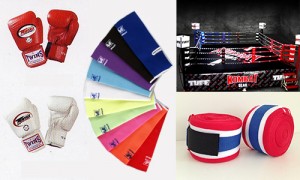 In Muay Thai ordinary competition, the ring should be square measuring 20 feet on each side for the small ring, and 24 feet on each side for big rings. Measurements take the inside of the ropes. There should be three ropes with a diameter of at least 1.90 centimeters and each rope is tied to the posts at the height of 18 inches, 35 inches and 52 inches respectively. The ropes are insulated with soft material and the inside of the four corners are also covered with soft material. Raised at least 4 to 5 feet at most, from the ground unobstructed, the edge should protrude at least 70 cm from the ropes. The posts should be of 4 x 4 inches and not higher than 58 inches from the ring floor. The floor should have a layer of soft rubber sheet, cork board or straw mat not less than 1.5 inches thick, covered by canvas tightly stretched to cover the whole ring area. Two ladders should be installed not less than 3.5 feet at the opposite ends to allow the officials, trainors and officials.
In Muay Thai ordinary competition, the ring should be square measuring 20 feet on each side for the small ring, and 24 feet on each side for big rings. Measurements take the inside of the ropes. There should be three ropes with a diameter of at least 1.90 centimeters and each rope is tied to the posts at the height of 18 inches, 35 inches and 52 inches respectively. The ropes are insulated with soft material and the inside of the four corners are also covered with soft material. Raised at least 4 to 5 feet at most, from the ground unobstructed, the edge should protrude at least 70 cm from the ropes. The posts should be of 4 x 4 inches and not higher than 58 inches from the ring floor. The floor should have a layer of soft rubber sheet, cork board or straw mat not less than 1.5 inches thick, covered by canvas tightly stretched to cover the whole ring area. Two ladders should be installed not less than 3.5 feet at the opposite ends to allow the officials, trainors and officials.
Rule No 2 – Gloves
Gloves should weigh not less than 4 ounces and not more than 6 ounces. Boxers should not change the shape, twist or crush the glove stuffing into distortion.
Rule No. 3 – The Hand Bandage
A standard surgical hand bandage of not more than 2 inches will follow the length requirements – 10 yards for flyweight to middleweight; 12 yards for light heavyweight to heavyweight. A plaster bandage may be used provided it is 1 inch wide and not less than 12 inches in length. Boxers are not allowed to use plaster bandage to bound round knuckles.
Rule No. 4 – Dress
Fighters must be dressed as follows:
- Groin protector is a must while mouth guard is optional.
- The pair of shorts which is either red or blue should be the same length as the upper thighs.
- No shirt and shoes shall be worn.
- The cotton laurel is put on only during the wai kruu. Cloth talisman tied to the upper arm or waist is allowed.
- Ankle support is allowed. Ankle bandage is not allowed
- Belt, necklace or any metal material is not allowed to be worn
- Use of Vaseline oil, herbs or any other scented material which opponent might consider repugnant is not allowed
Rule No. 5 – The Ring Equipment
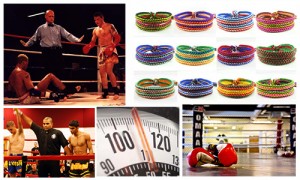 The following equipment should be seen at the ring – 2 seats, 2 bottles of water, 2 jugs, 2 buckets of water, 2 stools, and desks and chairs for the officials, gong with hammer or bell, 1 or 2 time clocks, score sheets and first aid kit and a microphone.
The following equipment should be seen at the ring – 2 seats, 2 bottles of water, 2 jugs, 2 buckets of water, 2 stools, and desks and chairs for the officials, gong with hammer or bell, 1 or 2 time clocks, score sheets and first aid kit and a microphone.
Rule No. 6 – Divisions and Weights
The divisions with their corresponding weight are as follows:
- Maximum of 118 pounds for Bantamweight
- 126 pounds for Featherweight
- 135 pounds for Lightweight
- 147 pounds for Welterweight
- 160 pounds for Middleweight
- 175 pounds for Light Heavyweight
- More than 175 pounds for Heavyweight
Age range of fighter should be between 17 years and 40 years of age.
Rule No. 7 – Weight Measurements
Weighing in happens between 9 and 12 hours prior to the competition start. If weight is over the limit, 12 hours will be given to have a second weighing in. If weight is not the correct weight, weighing in is deemed terminated. Weighing in can be done naked or in boxing attire minus the gloves. Fight will start only at least 3 full hours after the end of weighing in time. Proper examination on health condition of the fighters will be done by the appointed physician. Fighters must compete in one division only. A champion in the lower division may compete in a higher division.
Rule No. 8 – Number of Rounds
Regular competitions shall have no more than 5 rounds of three minutes per round and a minimum of three rounds. For championship final fight, there shall be no more than 6 rounds of 3 minutes each; 5 rounds minimum is required. Wai Kruu dance will be performed before the first round as per tradition. The fight can start only after the dance.
Rule No. 9 – Corner Men
Each fighter can have 2 corner men provided the corner men are not allowed to assist, advise or support the boxer while fighting; the corner men shall not be entitled to concede defeat on behalf of the fighter unless with a special agreement to that effect; the corner men and their assistants are not allowed to stay on the side of the ring before the start of each round – they shall remove towels and buckets, etc from the ring; the corner men must be politely dressed according to boxing standards, not allowing any publicity of any goods on the clothing except the name of the training camp; for the final fight, 3 corner men will be allowed for each fighter but the 3rd man can be on the platform outside the room while the 2 corner men stays inside the ring; if found to violate any rules, the corner men may be cautioned or stripped off the right to be corner men.
Rule No. 10 – The Judging Panel
The fight should have three judges – a referee judge and 2 score judges. These judges should be qualified by their long experience in the profession.
Rule No. 11 – The Referee Judge
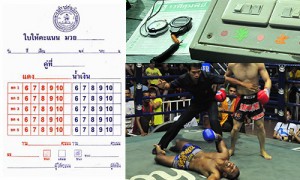 The referee judge is duty bound to make sure that the fight in the ring proceeds fairly and is following the rules. The referee should caution the fighter or corner men who do not follow the rules. He should also mark the score on the scorecard at the end of each round and check the scores on the judge’s scorecards at the end of the fight and announce the winner. He will also facilitate sending the checked score cards to the stadium master. The referee will use three words of instruction during the fight, namely, “stop”, “box” and “break”. The referee should point out some rules to the fighters and head corner man before the start of the first round.
The referee judge is duty bound to make sure that the fight in the ring proceeds fairly and is following the rules. The referee should caution the fighter or corner men who do not follow the rules. He should also mark the score on the scorecard at the end of each round and check the scores on the judge’s scorecards at the end of the fight and announce the winner. He will also facilitate sending the checked score cards to the stadium master. The referee will use three words of instruction during the fight, namely, “stop”, “box” and “break”. The referee should point out some rules to the fighters and head corner man before the start of the first round.
Rule No. 12 – Powers of the Referee
It is within the referee’s power to stop the fight if he deems the fight is not fair in terms of level of skills; if the fighter is so wounded and should not be allowed to continue; if the fighters are not performing seriously in which case the referee may expel one or both fighters. The referee can get the fighter to stop the fight so as to warn him in case he breaks the rules or enable the fight to continue fairly and following the rules. The referee can expel the fighter or the corner men who break the Muay Thai rules; expel the fighter who commits a foul from the other fighter regardless if he has been warned or not. The referee’s decision is deemed final. He shall interpret the rules as stipulated and can deliberate on a course of action based on the facts even if not governed by the rules.
These rules are imparted during Muay Thai training in any gym in the Kingdom to prepare the fighter in case the fighter decides to fight professionally. It is important to know the rules while on training to refrain from committing violations or worse case scenario, be thrown out of the a fight because of foul violations.
Muay Thai Advanced Training
Gaining popularity worldwide, Muay Thai is a combat sport and a martial art like no other. It originated from Thailand using stand-up striking along with various clinching techniques. It has been a popular sport for many young Thai and foreigners who take pains in learning and mastering the furious punches, lethal kicks, crushing elbow strikes, artful feints and powerful grappling. Muay Thai is a proud heritage of the kingdom of Thailand.

Muay Thai training camps in Thailand are spread over Phuket, Bangkok, Pattaya and Chiang Mai. These Muay Thai training camps offer training programs for beginners, intermediate and advanced training. Famed and well-known champion fighters normally supervise the training programs in Muay Thai training camps they have affiliations with. From beginner’s training, one can move up to the intermediate level where more complex techniques using all eight weapons (elbows, knees, shins and legs) are learned. The more complex techniques are incorporated to improve cardio/endurance, strength, speed and masterful ability to execute Muay Thai strikes and blocks properly.
From intermediate, the trainee will move to advanced training wherein more diverse striking Muay Thai techniques are taught. Some of the advanced Muay Thai techniques learned in advanced level include:

- Superman Punch. This punch is executed after throwing some low leg kicks to the opponent, intended to knock him out. It is used to surprise an opponent and get them worried about what strike is coming next.
- Spinning Back Fist. The spin is performed by putting one foot crossed behind the other, then pivoting the hip and having the elbow follow through. It is a sneaky technique that can catch the opponent by surprise. It can cause a lot of damage to the opponent if executed properly.
- Spinning Back Elbow. Very similar to a spinning back fist, a spinning back elbow can knock out the opponent with a powerful elbow strike.
- Flying Knee. This is done by jumping straight upwards horizontally aiming to strike the opponent’s chin, similar to an uppercut punch. It is used when close to the opponent and during a clinch, when the opponent is against the rope or wall.
- Switch Cross/Hook/Uppercut. When the opponent sees a quick switch in stance, it means a switch round-house kick or knee is coming. But with this technique, a switch cross, hook or uppercut is not seen coming.
- Muay Thai Sweeps. When standing, sweep is used to take an opponent to the ground by knocking their legs out from under them. The force of the sweep runs perpendicular to the opponent’s leg or rises as it strikes the leg, lifting the foot from the ground. It can also disrupt the opponent’s balance long enough to make an opening for a punch or kick.
Elbow Techniques in Muay Thai
Muay Thai as a form of combat sport has its own unique techniques. Muay Thai boxing techniques are the way to effectively use nine weapons which are the head, fists, elbows, knees and feet. Collectively, they are called Na-wa arwud. However, in today’s Muay Thai rules, head is no longer included as a weapon and not allowed in the Muay Thai fights. Muay Thai training Phuket fighters has removed the use of head in Muay Thai techniques.
Muay Thai techniques, as taught in a typical Muay Thai camp in Thailand, fighters trained are divided into two groups: Mae Mai or “major” or “master” techniques and Luk Mai or “minor” or “complementary” techniques. All Muay Thai techniques use the entire body movement, rotating the hip partially or fully with every punch, kick and block. This is what sets Muay Thai training apart from other forms of martial art.

While it may be possible to win a fight using just one technique, a Muay Thai boxer who masters the use of each of his eight weapons will definitely be able to face and outdo his opponent.
One of the eight lethal weapons learned in training is the Elbow technique. Muay Thai elbow techniques taught demonstrate how a fighter can properly use his elbows to beat the opponent. There are Muay Thai elbow techniques mechanism and nine types of elbow strikes in Muay Thai boxing, namely:
- Sok Ti (Striking Elbow or Elbow Slash)
- Sok Tad or Sok Tat (Perpendicular or Horizontal Elbow)
- Sok Ngat (Uppercut Elbow)
- Sok Phung (Forward Elbow Thrust)
- Sok Klap (Spinning Elbow)
- Sok Sap (Elbow Chop)
- Sok Ku or Sok Klap Khu (Double Elbows or Double Elbow Chop)
- Sok Wiang Klap (Reverse Horizontal Elbow)
- Kradot Sok (Mid-Air Elbow Strike)
In Muay Thai, the elbow is used in seven ways – horizontally, diagonal upwards, diagonal downwards, uppercut, downward, backward spinning and flying. It is also used from the sides as a finishing move or to cut the opponents’ eyebrow so that he bleeds. Bleeding blocks the vision and also affects the fighter’s performance. The diagonal elbows are less powerful but they are faster than the other forms.
There is also a distinct difference between a single elbow and a follow-up elbow. The single elbow is an elbow move, which is independent from any other move. A follow-up elbow, on the other hand, is the second strike from the same arm, being a hook or straight punch first with an elbow follow-up. Such elbows, and most other elbow strikes, are used when the distance between fighters is too small and there is too little space to throw a hook at the opponent’s head. Elbows can also be utilized to great effect as blocks or defenses against, for example, spring knees, side body knees, body kicks or punches.

The sport covers a lot of techniques in which a fighter is taught how to defend or attack another fighter with so much power and speed. Speed and accuracy in every attack is important to knock down an opponent while speed and proper mindset in anticipating attacks is critical to avoid being knocked down and to have good defense.
The elbow technique is just one of the lethal techniques in Muay Thai in combination with different power punches and kicks. Proper training, diet and tactical thinking also plays a big part in succeeding in the combat sports that is present in most Muay Thai training camp in Phuket and all over Thailand.
Muay Thai Punches
When training in a Muay Thai Camp in Thailand, Muay Thai would-be fighters are taught different techniques important to this combat sport from Thailand. One of such techniques is the Muay Thai punch. Muay Thai training in Thailand promotes and had seen numerous local Thai and foreign fighters develop into strong and successful Muay Thai world champions. It just proves the kind of Muay Thai Training Phuket gyms offer – one that ensures a trainee a successful career in kickboxing.
A basic of Muay Thai techniques is the Muay Thai punches. At a time when men did not have any weapon to fight wild animals and even human beings as well, they made use of every part of their body as a defensive weapon needed for survival. Punch is the easiest defensive and offensive weapon to control compared to the other parts of the body.
What to Hit with Muay Thai Punch
In Muay Thai gym Phuket trainers emphasize the proper Muay Thai Punch techniques in order to accurately hit the target. The fighter should use the knuckles as this is the most effective way to hit the target. The usual target of a Muay Thai fighter is the area of the upper body towards the face. But regardless of where the punch hit the target, it is important to remember to immediately pull back the fist away from the opponent in order to prevent exposing the fighter to counter-punching of the opponent. The punch thrown should unnerve the opponent.
There are five categories of Muay Thai punches, which are learned in any Muay Thai a gym Thailand is plentiful. These are:
The Jab
This is used to find the range by irritating the opponent. Accurate and skillful jabbing will cause the opponent to feel anxious. This punch requires a lot of practice on the punching bag. This type of punch could be used in defense, attack or retreat.

The Straight Punch
Muay Thai trainers ensure that each fighter is taught to use straight punch mainly to attack the opponent’s facial area such as chin, nose, or mouth. The knuckles are used to increase the effectiveness of this punch along with twisting the opponent’s shoulders. Straight punch is always use after the jab.
The Hook
This punch is used mainly to attack side facial area such as the temple, nose, or ear. The elbow is bent a bit and the back of the knuckle is used to attack. To increase the effectiveness of the hook, a fighter may combine the hook with twisting the opponent’s shoulders.
The Swing
This type of punch is generally thrown at a further distance than the distance covered by the hook. Targeted by swings are areas around the jaw line or the ribs. When there is a gap on the opponent’s body or face, a swing can be thrown. As the punch hits the target, make sure that the knuckles take the brunt of the impact.
The Uppercut
Muay Thai fighters use the uppercut punches to target to attack the opponent’s chin and stomach. To do the uppercut, knees and elbows are bent slightly before a punch is made vertically to attack the opponent. When the opponent is very close to the Muay Thai fighter or when they are in a stooping position, the uppercut will be more effective. Alternatively, it is also possible to attack by knee kick instead of uppercut.
Muay Thai punches if combined with different style of kicks could badly hurt an opponent especially if it’s done with so much power. Everyday intensive Muay Thai training enhances a fighter’s skill and senses in mastering the art of the sport, which could make any fighter one of the best.





